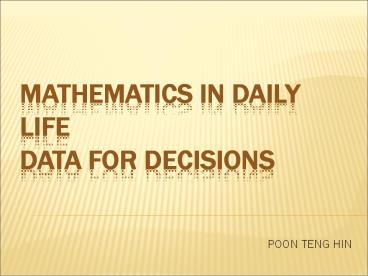Mathematics in Daily Life Data for Decisions - PowerPoint PPT Presentation
Title:
Mathematics in Daily Life Data for Decisions
Description:
POON TENG HIN End * * Introduction Critical thinking When we are reading articles or making decisions, we need to ask: What is the statements? – PowerPoint PPT presentation
Number of Views:804
Avg rating:3.0/5.0
Title: Mathematics in Daily Life Data for Decisions
1
Mathematics in Daily LifeData for Decisions
-
POON TENG HIN
2
Introduction
3
Critical thinking
- When we are reading articles or making decisions,
we need to ask - What is the statements?
- What is the conclusion/decision?
- What are the reasons for supporting the
- Conclusion/decision?
4
Data as reason
- One of the effective reasons to support a
conclusion is Data.
5
More examples
Consumer survey
Marketing Plan
6
Sampling
7
Sampling
- Demo ?
8
Sampling methods
9
(No Transcript)
10
Sampling Methods
- Non Probability sampling
- Does not involve random selection
- Probability sampling
- Involve random selection
11
For your reference(explanation from web)
- Purposive Sampling Select particular group of
people. The accuracy depends on how to select. - Accidental sampling involves the sample being
drawn from that part of the population which is
close to hand. That is, a sample population
selected because it is readily available and
convenient. - Quota sampling means the population is first
segmented into mutually exclusive sub-groups and
select samples in each sub-group with a quota. - Convenience sampling the researcher uses
subjects that are easy to reach. - Snowball sampling existing samples recruit
future sample from among their acquaintances.
Thus the sample group appears to grow like a
rolling snowball.
12
For your reference(explanation from web)
- Simple random sample each unit of the
population has an equal chance of being selected
for the sample. - System Random Sampling starting point is
chosen at random, and thereafter take sample at
regular intervals. - Stratified Random Sampling process of
dividing members of the population into
homogeneous subgroups before sampling. Then
random or systematic sampling is applied within
each stratum. - Cluster Sampling the total population is
divided into these groups (or clusters) and
a sample of the groups is selected. Then the
samples are collected from the elements within
each selected group. - Multi-Stage Sampling First stage is
cluster sampling, then randomly selects elements
from each cluster.
13
Non Probability sampling
14
(No Transcript)
15
Login
16
E.G I have been invited in a event
17
Which sampling method does it involved?
Purposive Sampling Accidental
Sampling Quota Sampling
Convenience sampling
Topic Compare the motivation of leisure
activities between working people and people in
school
18
Snowball sampling
If the people attended in the event can invite
their friends into it, then it is a kind of
Snowball Sampling
19
Voluntary response sample
When participants could choose to participate or
not. This causes some bias.
20
Response rate
However, Some people do not attend..
21
Response rate
- Response rate
- (Respondents / Sample size) X 100
22
How response rate effect the result?
- If the response rate are low
- E.g. Sample size 100, response rate 40
- Result Agree 25 (most
people agree) - Disagree15
- Non attended Agree 25
- Disagree35 (most
people disagree) - Total Agree 50 (Different
results) - Disagree50
23
Response Bias
- If response rate is low, the accuracy of the
sampling will decrease. - We should aware of the response rate when we make
decision.
24
Non Probability sampling
25
(No Transcript)
26
Simple Random Sampling
- Each unit of the population has an equal chance
of being selected for the sample. - Methods
- Drawing
- Table of random numbers
- Computer programs
27
Table of random numbers
28
Use the table
- Decide how large a number you need before.
- Decide how to across the page. To the right, to
the right, down the page or up the page.
29
(No Transcript)
30
E.G If we marked 100 tigers, and fond 2
marked tigers in 60 afterward so
2/60 100/N
N 3000 3000 tigers in the area.
31
How can the conclusion be affected?
- Tigers are live animal, we cannot control it.
- Marked tiger may die, or be alertness.
- Non Living may get better accuracy.
32
Conclusion
- Should aware of the choosing of sampling methods
and understand how a survey conducted before
believe in it.
33
Homework
- Suggest a process using simple random sampling to
determine the height of UST students - 2. If I marked 200 fish and released them in the
pool, after 2 days, I catch 200 fish and there
are 40 of them are marked. What is the population
of the fish in the pool? What factors may affect
the result? - Extra credit What factors will affect the
sample size?
34
End































